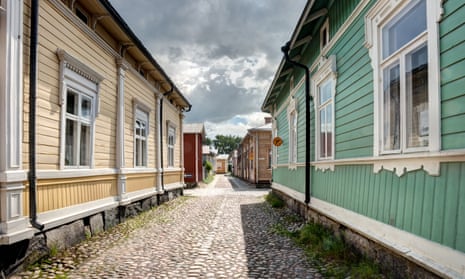The city of a smidgen under 40,000 people on Finland’s west coast, clustered around an immaculate Unesco-garlanded wooden old town, celebrates its 575th anniversary this week. Depending on how you classify these things, that makes Rauma either the country’s third, fourth or fifth oldest chartered town. Anyway, it’s old … with enough of a concentration of culture to make Unesco look twice: the bronze age cairns at nearby Sammallahdenmäki also made it on to the World Heritage list.

Finland’s gateway
“It means a lot,” says 33-year-old freelance writer and travel blogger Saana Jaakkola, who has lived here for 12 years. “People here are very proud of their roots. It’s boosting how proud we are about our hometown – which has been a little bit forgotten about by the rest of Finland.”
The marketplace is the focus for the anniversary programme – including theatre in the local dialect, concerts, dance and children’s events – that culminates on 19 April. Rauma’s big day falls in the auspicious centenary year for the whole country – but the town has always looked further. The dialect, still spoken by older residents, borrows from Swedish, Estonian and German, the regions with which Rauma had its original trade links. Various international businesses – a Rolls-Royce plant, a neighbouring Franco-German nuclear power plant – mean it is surprisingly cosmopolitan for a small place.
City in numbers …
800 Residents in the old town
57 Vessels in the town’s fleet in 1897, Finland’s largest at the time
5.6m Tonnes of freight in 2016 handled by the port, the country’s fifth largest
99 Percentage of the town’s heating supplied from the local paper mill site, its key industry. “Sometimes when the wind is right, it brings weird smells into the town from the mill,” says Jaakkola. “We have a saying: ‘That’s the smell of money.’”
… and pictures
Local artist Tarmo Thorström has created light artworks that, projected on to the town hall during the last two winters, pay tribute to Rauma’s long lace-making tradition.
This article includes content provided by Instagram. We ask for your permission before anything is loaded, as they may be using cookies and other technologies. To view this content, click 'Allow and continue'.
History in 100 words
Rauma has always had a salty tang about it. The town chartered in 1442 had grown up around a Franciscan monastery, but it became an important medieval port. Their laxmän (salmon men) as they were known in Stockholm, ran fish, fur, seal blubber and animal skins over the Gulf of Bothnia to the Swedish capital, to Tallinn and the Hanseatic cities. Later, it was timber to England and the Mediterranean, and now paper.
The seafaring legacy can still be seen in the windows of the old town, Jaakkola says. “You might see little dog statues there. When the husbands were away at sea, then the wives might have had some, ahem, other visitors. If the dog was facing out on to the street, that meant it’s safe to come; but if it was facing indoors, it meant the husband is home – don’t come. Maybe they just send chat messages now.”
Rauma in sound and vision
The pristine Nordic structures of the old town were the inspiration for Sim City-style video game City of Rauma by local boy Juho Ruohola.
RMJ electronic music festival returned to Rauma in 2016 after a brief hiatus, and will take place again on 22-24 June. Here’s a short blast from last year’s headliner David Guetta.
What’s everyone talking about?
Six hundred people lost their jobs when Korean company STX pulled out of the local shipyards at the end of 2013. “It was a huge shock, a complete mess,” says Jaakkola. But it’s turned into a story of plucky self-sufficiency to warm the cockles of local enterprise advocates everywhere. The municipality bought the property for €18m, and Rauma Marine Constructions was born in 2014, ensuring jobs were saved and 500 years of shipbuilding continued.
“Now it’s growing fast, with lots of new orders,” says Jaakkola. One included a 5,000-tonne deck towed last year to its final mooring place off the Burj al-Arab hotel in Dubai; the Finnish navy has just ordered four new vessels.
This article includes content provided by Instagram. We ask for your permission before anything is loaded, as they may be using cookies and other technologies. To view this content, click 'Allow and continue'.
What’s next for the city?
In addition to the port, Rauma also has one of Finland’s largest leisure marinas. “People here don’t ask what kind of house you have, or how much money you have. They ask what kind of boat you have,” says Jaakkola.
The town’s looking to bolster its modern tourism capacity away from the old town – further development of the coastal area (perhaps neglected because of the 30-minute walk from the centre, which was next to the coast during medieval times) is coming. It’s being driven by “hands-on” local businessman Riku Räsänen, who founded the RMJ festival and owns the Poroholma camping site where part of it takes place. An adjacent outdoor swimming pool, which had fallen into disrepair, is also due to reopen in 2018 under Räsänen’s stewardship.
Close zoom
If your Finnish is up to scratch, local rag Länsi-Suomi will tell you everything you need to know. Otherwise, the city’s website is your best bet.
Follow Guardian Cities on Twitter and Facebook to join the discussion, and explore our archive here

Comments (…)
Sign in or create your Guardian account to join the discussion